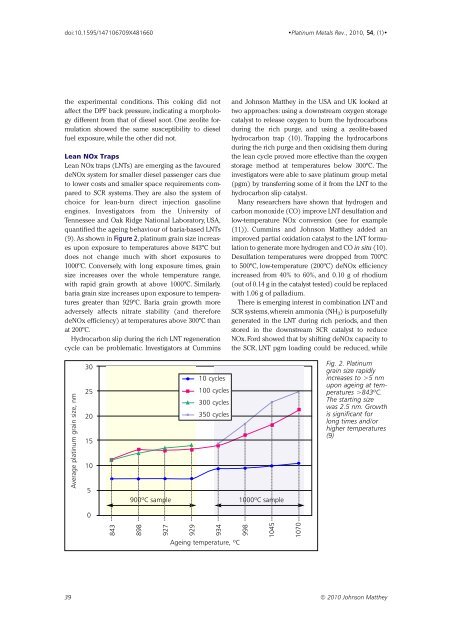Download Issue PDF - Platinum Metals Review
Download Issue PDF - Platinum Metals Review
Download Issue PDF - Platinum Metals Review
You also want an ePaper? Increase the reach of your titles
YUMPU automatically turns print PDFs into web optimized ePapers that Google loves.
doi:10.1595/147106709X481660<br />
•<strong>Platinum</strong> <strong>Metals</strong> Rev., 2010, 54, (1)•<br />
the experimental conditions. This coking did not<br />
affect the DPF back pressure, indicating a morphology<br />
different from that of diesel soot. One zeolite formulation<br />
showed the same susceptibility to diesel<br />
fuel exposure, while the other did not.<br />
Lean NOx Traps<br />
Lean NOx traps (LNTs) are emerging as the favoured<br />
deNOx system for smaller diesel passenger cars due<br />
to lower costs and smaller space requirements compared<br />
to SCR systems. They are also the system of<br />
choice for lean-burn direct injection gasoline<br />
engines. Investigators from the University of<br />
Tennessee and Oak Ridge National Laboratory, USA,<br />
quantified the ageing behaviour of baria-based LNTs<br />
(9). As shown in Figure 2,platinum grain size increases<br />
upon exposure to temperatures above 843ºC but<br />
does not change much with short exposures to<br />
1000ºC. Conversely, with long exposure times, grain<br />
size increases over the whole temperature range,<br />
with rapid grain growth at above 1000ºC. Similarly,<br />
baria grain size increases upon exposure to temperatures<br />
greater than 929ºC. Baria grain growth more<br />
adversely affects nitrate stability (and therefore<br />
deNOx efficiency) at temperatures above 300ºC than<br />
at 200ºC.<br />
Hydrocarbon slip during the rich LNT regeneration<br />
cycle can be problematic. Investigators at Cummins<br />
and Johnson Matthey in the USA and UK looked at<br />
two approaches: using a downstream oxygen storage<br />
catalyst to release oxygen to burn the hydrocarbons<br />
during the rich purge, and using a zeolite-based<br />
hydrocarbon trap (10). Trapping the hydrocarbons<br />
during the rich purge and then oxidising them during<br />
the lean cycle proved more effective than the oxygen<br />
storage method at temperatures below 300ºC. The<br />
investigators were able to save platinum group metal<br />
(pgm) by transferring some of it from the LNT to the<br />
hydrocarbon slip catalyst.<br />
Many researchers have shown that hydrogen and<br />
carbon monoxide (CO) improve LNT desulfation and<br />
low-temperature NOx conversion (see for example<br />
(11)). Cummins and Johnson Matthey added an<br />
improved partial oxidation catalyst to the LNT formulation<br />
to generate more hydrogen and CO in situ (10).<br />
Desulfation temperatures were dropped from 700ºC<br />
to 500ºC, low-temperature (200ºC) deNOx efficiency<br />
increased from 40% to 60%, and 0.10 g of rhodium<br />
(out of 0.14 g in the catalyst tested) could be replaced<br />
with 1.06 g of palladium.<br />
There is emerging interest in combination LNT and<br />
SCR systems,wherein ammonia (NH 3 ) is purposefully<br />
generated in the LNT during rich periods, and then<br />
stored in the downstream SCR catalyst to reduce<br />
NOx. Ford showed that by shifting deNOx capacity to<br />
the SCR, LNT pgm loading could be reduced, while<br />
Average platinum grain size, nm<br />
30<br />
25<br />
20<br />
15<br />
10<br />
5<br />
10 cycles<br />
100 cycles<br />
300 cycles<br />
350 cycles<br />
900ºC sample 1000ºC sample<br />
Fig. 2. <strong>Platinum</strong><br />
grain size rapidly<br />
increases to >5 nm<br />
upon ageing at temperatures<br />
>843ºC.<br />
The starting size<br />
was 2.5 nm. Growth<br />
is significant for<br />
long times and/or<br />
higher temperatures<br />
(9)<br />
0<br />
843<br />
898<br />
927<br />
929<br />
934<br />
998<br />
Ageing temperature, ºC<br />
1045<br />
1070<br />
39 © 2010 Johnson Matthey
















